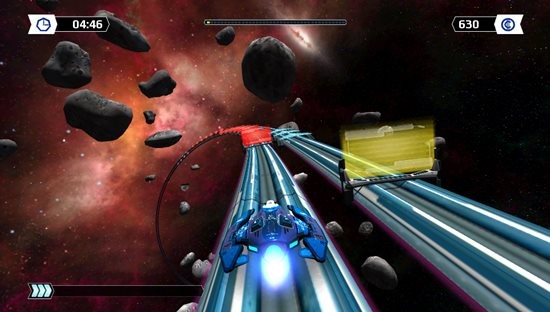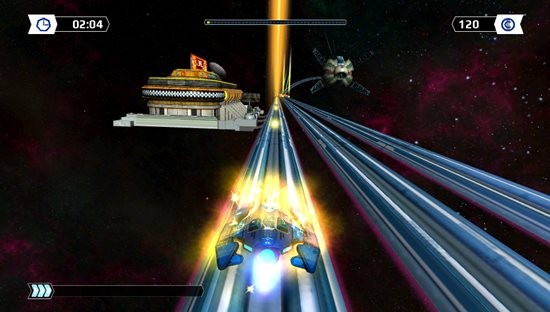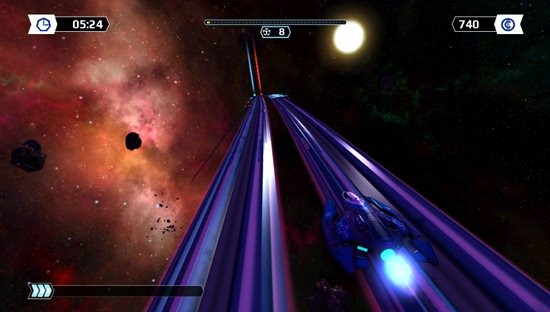Also On: PS4
Publisher: Atomicom
Developer: Atomicom
Medium: Digital
Players: 1-4
Online: Yes
ESRB: E
I know what you’re thinking. You’re looking at Switch Galaxy Ultra’s screenshots, and you’re seeing those sleek ships and that space-age setting, and it’s inevitable. You’re thinking that this game borrows heavily from Wipeout. Maybe F-Zero if you’re in a retro kind of mood. Either way, you probably think you know exactly what this game has in store for you.
You’d be wrong, though. While Switch Galaxy Ultra may borrow heavily from the Wipeout/F-Zero school of design — to the point the cutscene comics were done by original Wipeout concept artist Darren Douglas — its actual gameplay isn’t all that similar. In fact, if you really want an analogue, you need to look to a different game: Battletoads.
Or, to be more precise, the turbo tunnels. You know the ones. The levels that every NES gamer simultaneously feared and loved. The one that made a generation of kids fling controllers in frustration. The one part of the game that people still remember vividly, decades after the fact. Those levels.
Of course, the comparison isn’t perfect, and it’s doubtful Switch Galaxy Ultra will be the same source of nostalgia for 30-somethings in the mid-2030s that Battletoads is today. For starters, because it borrows so heavily from other games, it doesn’t have that same revelatory feeling that its antecedents had. Nor is it as difficult — sure, it gets harder the further in you get, but at no time did I want to hurl my Vita across the room. (Not that that’s necessarily a bad thing, mind you, but I doubt Battletoads’ turbo tunnels would evoke the same emotions decades after the fact if they’d been easy to beat.)
Most importantly, though, the gameplay just isn’t there. The whole game is a little too one-note. Obviously, not every game needs to have varied gameplay, but here, you’re essentially doing the same thing in the 55th level that you’re doing in the first. This, in turn, speaks to that difficulty issue, and that even if the game occasionally adds in new obstacles, it still starts feeling like you’re just doing the same thing over and over again after awhile.
Even worse, the controls aren’t as precise enough as they need to be for the game to pull off what it wants to do. During the regular portions of the track, this isn’t too bad a thing; you’ll occasionally switch lanes into an obstacle too early or you won’t switch onto an acceleration pad quick enough, but those things are minor annoyances. What’s less cool is the lack of precision during the special sections, when you’re going at warp speed collecting Tantalum. Here, it’s much harder to judge exactly where you are in relation to the glowing orbs, which means that collecting all of them is a bit of a pain. Considering that you only advance in the game as long as you have a certain number of Tantalum, that quickly becomes an issue as you have to go back and keep trying (and retrying) earlier levels in order to move on.
Despite these issues, however, I still really enjoyed Switch Galaxy Ultra. Maybe it just hit my nostalgic sweet spot, but there was something fun about zipping back and forth between lanes, dodging all the obstacles in my path. Even if you never reach the speed of the turbo tunnel, you still zip along at a nice pace, and the game conveys that really well. Likewise, the designs may not be all that original, but that doesn’t mean they don’t look fantastic.
Obviously, though, that’s going to come as a disappointed to anyone who was hoping for this generation’s version of Wipeout. Because, well, Switch Galaxy Ultra isn’t that. And hey, even taking the game for what it is, it’s still a little lacking. But not every game has to reinvent the wheel — sometimes it’s enough to just borrow from more established franchises and hope for the best. As Switch Galaxy Ultra shows, that may not be the perfect formula, but it’s enough to make an alright game.




